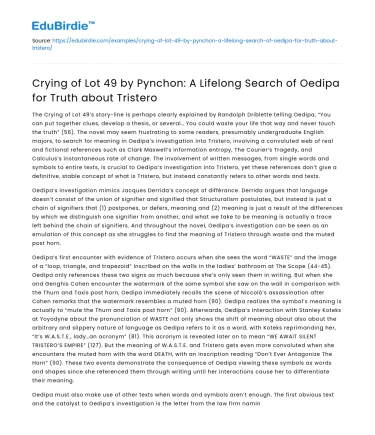The Crying of Lot 49’s story-line is perhaps clearly explained by Randolph Driblette telling Oedipa, “You can put together clues, develop a thesis, or several… You could waste your life that way and never touch the truth” (56). The novel may seem frustrating to some readers, presumably undergraduate English majors, to search for meaning in Oedipa’s investigation into Tristero, involving a convoluted web of real and fictional references such as Clark Maxwell’s information entropy, The Courier’s Tragedy, and Calculus’s instantaneous rate of change. The involvement of written messages, from single words and symbols to entire texts, is crucial to Oedipa’s investigation into Tristero, yet these references don’t give a definitive, stable concept of what is Tristero, but instead constantly refers to other words and texts.
Oedipa’s investigation mimics Jacques Derrida’s concept of différance. Derrida argues that language doesn’t consist of the union of signifier and signified that Structuralism postulates, but instead is just a chain of signifiers that (1) postpones, or defers, meaning and (2) meaning is just a result of the differences by which we distinguish one signifier from another, and what we take to be meaning is actually a trace left behind the chain of signifiers. And throughout the novel, Oedipa’s investigation can be seen as an emulation of this concept as she struggles to find the meaning of Tristero through waste and the muted post horn.
Save your time!
We can take care of your essay
- Proper editing and formatting
- Free revision, title page, and bibliography
- Flexible prices and money-back guarantee
Oedipa’s first encounter with evidence of Tristero occurs when she sees the word “WASTE” and the image of a “loop, triangle, and trapezoid” inscribed on the walls in the ladies’ bathroom at The Scope (44-45). Oedipa only references these two signs as much because she’s only seen them in writing. But when she and Genghis Cohen encounter the watermark of the same symbol she saw on the wall in comparison with the Thurn and Taxis post horn, Oedipa immediately recalls the scene of Niccoló’s assassination after Cohen remarks that the watermark resembles a muted horn (90). Oedipa realizes the symbol’s meaning is actually to “mute the Thurn and Taxis post horn” (90). Afterwards, Oedipa’s interaction with Stanley Koteks at Yoyodyne about the pronunciation of WASTE not only shows the shift of meaning about also about the arbitrary and slippery nature of language as Oedipa refers to it as a word, with Koteks reprimanding her, “It’s W.A.S.T.E., lady…an acronym” (81). This acronym is revealed later on to mean “WE AWAIT SILENT TRISTERO’S EMPIRE” (127). But the meaning of W.A.S.T.E. and Tristero gets even more convoluted when she encounters the muted horn with the word DEATH, with an inscription reading “Don’t Ever Antagonize The Horn” (90). These two events demonstrate the consequence of Oedipa viewing these symbols as words and shapes since she referenced them through writing until her interactions cause her to differentiate their meaning.
Oedipa must also make use of other texts when words and symbols aren’t enough. The first obvious text and the catalyst to Oedipa’s investigation is the letter from the law firm naming her as a co-executor of Pierce Inverarity’s will at the beginning of the novel. The meaning of why Oedipa was named co-executor of Pierce’s will, much like the already dead Pierce, fades into the background of the storyline like a “shadow,” only to return later on (2). She also searches for the original version of The Courier’s Tragedy in the plagiarized anthology Jacobean Reference Plays at Zapf’s Used Books (55). She also attempts to piece together the beginnings of Trystero by consulting “obscure philatelic journals…an ambiguous footnote in Motley’s Rise of the Dutch Republic, an 80-year-old pamphlet on the roots of modern anarchism, a book of sermons…” (119). Oedipa searches endlessly through texts, trying to pursue connections between them and finding any clues.
For the reader, Oedipa’s investigation feels like looking through a dictionary to find a definition for a word, only to be given more words that are even further defined by more words. Even Mucho’s nickname for Oedipa, “Oed,” can be seen as an abbreviation for OED, of the Oxford English Dictionary. And Oedipa feels like a living dictionary or reference, “pursuing strange words in Jacobean texts” (76). She’s even self-aware that she may never reach the true meaning of these clues, lamenting that she can “never [know] the central truth itself” (69). Her investigation into the true meaning of Tristero is fruitless, even with “the image of the muted post horn all but saturating the Bay Area” (98). Each clue is “only some kind of compensation. To make up for her having lost the direct, epileptic Word…” (87) that only informs her, “If you know what this means… you know where to find out more” (99). Yet, she always ended “back where’d she started” (97). Like a chain of signifiers, the clues in Oedipa’s investigation only refer to other clues, never reaching a definite point of meaning.
At the end of the novel, there is no resolution on whether or not Tristero exists. But it does provide some relief for Oedipa, who no longer has to search through messages and texts to find their meanings, but instead she has to identify the anonymous bidder just by “await[ing] the crying of lot 49” (138). Since language has signifiers constantly referring to one another, nothing can exist outside of language. Throughout the novel, Oedipa wanders through an endless stream of texts and trying to find meaning by making connections. It isn’t until she realizes Tristero cannot exist outside of written text that she decides to step out of its confines. And at that moment, she is perhaps closer to the truth of Tristero’s existence than any of us will ever be.






 Stuck on your essay?
Stuck on your essay?

